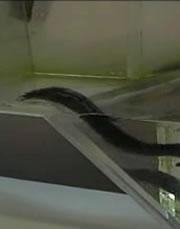 Click here to see a video.Credit: Sam Van Wassenbergh
Click here to see a video.Credit: Sam Van WassenberghZoologists have found a remarkable fish that can wriggle from Africa's tropical swamps to snaffle a snack on land.
The eel catfish, Channallabes apus, catches unsuspecting victims by arching upwards and descending upon prey, trapping an insect against the ground before sucking it up. It performs this trick thanks to a bendy neck supported by specialized vertebrae, which allows it to hover over prey without needing fins or arms to hold up its head.
The same trick may have been used by the very first vertebrates to venture onto land, the researchers speculate.
Tropical snapper
“It lives in a very inhospitable environment - where not many biologists pass by.”
Sam Van Wassenbergh
University of Antwerp
Sam Van Wassenbergh of the University of Antwerp in Belgium and his team present the observation, complete with video evidence, in this week's Nature1. The trick has never been recorded before, says Van Wassenbergh. "This catfish lives in a very inhospitable environment in the tropical swamps of Africa, where not many biologists pass by."
Most fish capture dinner by opening wide and expanding their mouth cavity: this pulls in extra water and sucks up prey. But this only works below the surface; animals cannot create the same amount of suction by opening their mouths in air, which is 800 times less dense than water.
Animals have evolved various strategies to capture insects on land, from sticky tongues to lightning-fast lunges and snapping jaws. For C. apus, the solution consists of being able to loom over its target with its mouth in a position to engulf it from directly from above.
Skipping dinner
ADVERTISEMENT
Other fish known to hunt on land, called mudskippers, also have extremely flexible necks, Van Wassenbergh points out. He suspects that this trick might be the best way for a fish to catch a meal on dry land. "I don't think there are any other options," he reflects.
And the eel catfish, although a modern species, may demonstrate just how the first vertebrates graduating to land caught their dinner. Palaeontologists last week unveiled fossils of Tiktaalik roseae, a creature that had limb-like bones encased in fleshy fins (see 'The fish that crawled out of the water'). Tiktaalik roseae certainly seems to have had a fairly versatile neck, notes Van Wassenbergh.
Visit our fishthathuntson_land.html">newsblog to read and post comments about this story.
University of Antwerp
-
References
- Van Wassenbergh S., et al. Nature, 440. 881 (2006). | Article |
